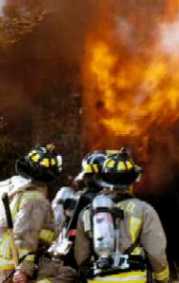
|
|

|
|
Fire Extinguisher:
First Aid In Firefighting
This is a brief overview of the important points of using a portable fire extinguisher. Fire can be devastating, but when used properly, a fire extinguisher can save lives and property.
|
|
Fire is the process that occurs when heat, fuel, and oxygen join together, either by chemical chain reaction, Nature or by human intervention. Fire extinguishers work by removing one of these items. Fire can be prevented by keeping these items away from each other.
TYPES OF FIRE
There are three common types or classes of fire:
CLASS "A": class "A" type fires involve ordinary combustibles such as: wood, paper, cloth, rubber, and many plastics.
CLASS "B": class "B" type fires involve flammable liquids such as: gasoline, oil, grease, tar, oil-based paints, lacquer, and flammable gases.
CLASS "C": class "C" type fires involve energized electrical equipment such as: wiring, fuse boxes, circuit breakers, machinery, and appliances.
Fire extinguishers are tested to determine what class of fire they are suitable for. Fire extinguishers will be marked as to which fires they may or may not be used on. Make sure the fire extinguisher you select is rated for the class of fire you intend to fight. It is recommended that you use the ABC-type fire extinguisher.
USING A FIRE EXTINGUISHER
The "PASS" word is a method for operating most common fire extinguishers. It is a four step method.
"P" stands for PULL the pin. This will unlock the operating handle and allow you to discharge the extinguisher.
"A"stands for AIM at the base of the fire.
"S" stands for SQUEEZE the operating handle. This will discharge the fire fighting agent.
"S" stands for SWEEP from side to side. Move carefully in on the fire, aiming at the base, sweep back and forth.
Back To Top
|
|


